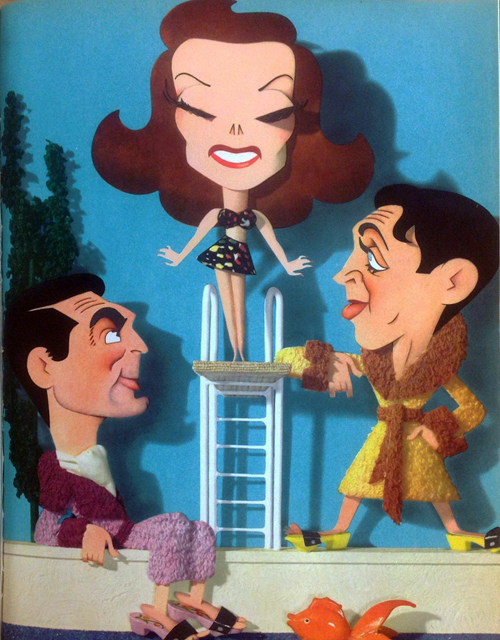They had time for everything then
Monday | April 20, 2015 open printable version
open printable version
Advertisement for Woman of the Year. From Hollywood Reporter (23 April 1942), 5.
During the 1940s, MGM promoted some of its top pictures with unique illustrations. The artist would make cutout caricatures of the stars, dress them in fabrics, and then prepare little shallow-relief scenes, with props made of wood, carpets, and other stuff. Above, the microphones seem made of metal and plastic, and Tracy’s coat has real buttons attached. Below, the men’s slippers are three-dimensional, as is the toy goldfish and, I suppose, the diving board.
The little tableau would then be photographed, in luscious color. Some were printed with elaborately embossed borders.
I say “the artist” because he or she goes unidentified on these advertisements. The only signature is an enigmatic “K”; in the image above, it’s on the tiny baseball at the bottom. If anyone knows who K is, or can supply further background, please correspond.
Interestingly, these charming images continued to be published from time to time through the early years of the war. I’m afraid my reproductions don’t do them justice, but you get the idea.
Damn, but film research is fun.
P.S. 24 April 2015: Ask and ye shall receive. Alert reader Mark Schoenecker writes:
I’m sure you’ve already received correspondence naming the identity of the mysterious MGM illustrator responsible for those distinctive 3D paper sculpture pieces from the 30s and 40s — but in case you haven’t, his name is Jacques Kapralik. I’m an illustrator myself and have always been vaguely aware of the existence of these cut-out posters. What I didn’t know was that one man was behind them. I’d assumed it was a style prevalent during that era. It wasn’t until I found myself drawing my own series of caricatures in a similar vein that I decided to track down the originals online to see if I was remembering them accurately.
Here is a link to the most interesting article I came across: https://mubi.com/notebook/posts/movie-poster-of-the-week-the-jacques-kapralik-archive
I should’ve known that the indispensable MUBI would have something on this. It’s a fine piece of work by Adrian Curry, showing that Kapralik did movie title sequences as well. Be sure to check the links in that entry and the comments. The University of Wyoming holds Kapralik’s collection, and an online finding aid gives access to many of his beauties.
Many thanks to Mark for clueing me to this. You should immediately check Mark’s own lively, dry, and sometimes scathing, caricatures here. Who else thinks of drawing Dorothy Kilgallen and Korla Pandit?
Advertisement for the The Philadelphia Story. From The Hollywood Reporter (31 December 1940), 7.















